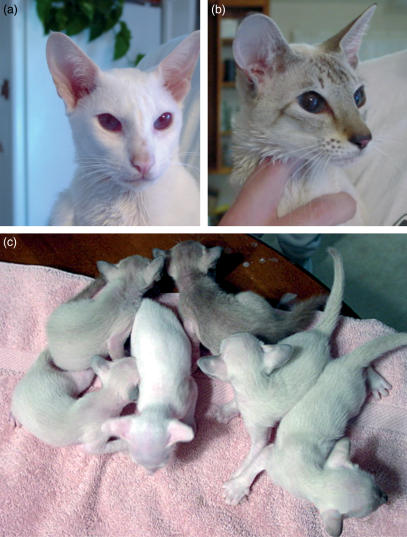
Allelic series at the
Colour locus in
domestic cats
Like other
mammals, some cats are albino due to defects in tyrosinase
metabolism. The illustration shows an albino (a)
[left] and her colour-point (chocolate
lynx-point non-albino) sibling (b) [right]. The litter of kittens in the lower
photo includes an albino
and a colourpoint kitten (third from the left and right,
respectively). The kittens have not yet developed colour points.
Cats and other mammals express two forms of
melanin, called eumelanin
(black) and phaeomelanin
(orange), respectively. Mutations at the
tyrosinase locus (TYR)
affect both pigments, and produce dilute forms of
each. The typical "points"
of siamese and
burmese
cats result from a
temperature-sensitive form
of albinism, in which eumelanin
pigment
develops only in the cooler extremities, such as ears, paws, and
tail. The degree of darkness of these features is determined
by the exact form of eumelanin, which is determined by a series of
four
alleles:
C [or c+] (full
colour) > cb (burmese) ~ cs (siamese) > c (albino).
C
(c+) is fully dominant to those below it,
cb has brown points, and cs black points. Show-quality burmese
and siamese cats are homozygous cbcb and cscs respectively. Heterozygotes (cb/cs) show a colour called tonkinese that
is intermediate between burmese
and siamese colouration.
The first three alleles are fully dominant to c.
For more on cat coat colour genetics see [http://www.vgl.ucdavis.edu/service/cat/coatcolor.html].
Photo from Imes et
al. 2005 Animal Genetics 37, 1315; additional text
material
©2011 by Steven M. Carr

